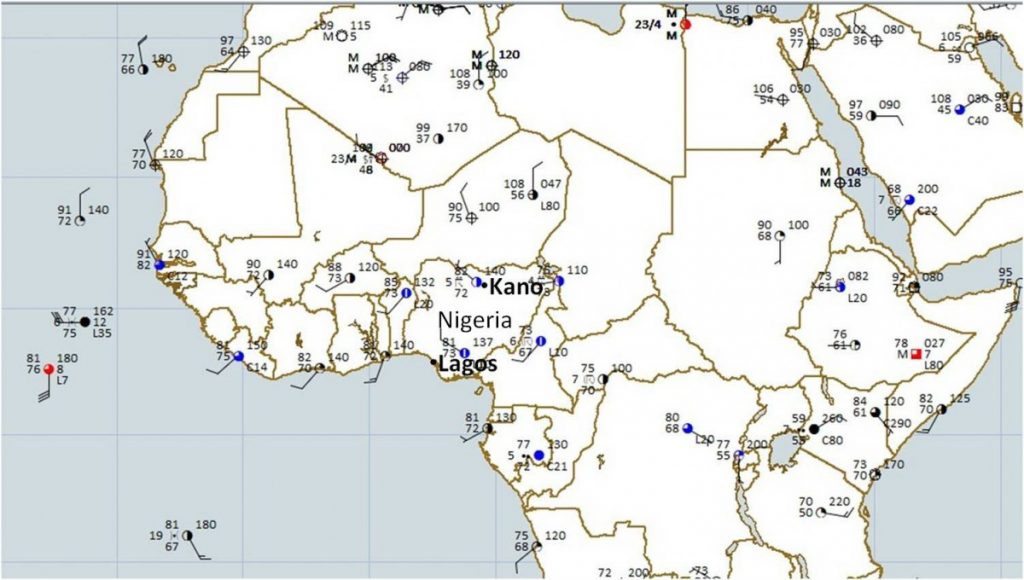The Inter-Tropical Convergence Zone (ITCZ – pronounced “itch”) appears as a band of clouds consisting of showers, with occasional thunderstorms, that encircles the globe near the equator. The solid band of clouds may extend for many hundreds of miles and is sometimes broken into smaller line segments.
It exists because of the convergence of the trade winds. In the northern hemisphere the northeast trade winds converge with southeast winds from the Southern Hemisphere. The point at which the trade winds converge forces the air up into the atmosphere, forming the ITCZ.


The tendency for convective storms in the tropics is to be short in their duration, usually on a small scale. But these short lived storms can produce intense rainfall. It is estimated that 40 percent of all tropical rainfall rates exceed one inch per hour.
The ITCZ follows the sun in that the position varies seasonally. It moves north in the Northern Hemisphere summer and south in the Northern Hemisphere winter. Therefore, the ITCZ is responsible for the wet and dry seasons in the tropics.
The sun crosses the equator twice a year in March and September, and consequently makes for two wet seasons each year. In December and July, when the sun is at its greatest extent north (or south) of the equator makes for two dry seasons.
Further away from the equator, the two wet seasons merge into one, and the climate becomes more monsoonal, with one wet season and one dry season. In the Northern Hemisphere, the wet season occurs from May to July, in the Southern Hemisphere from November to February.
Tale of Two Cities: Kano and Lagos
Because of its location just north of the equator, Nigeria’s climate is characterized by the hot and wet conditions associated with the movement of the Inter-Tropical Convergence Zone (ITCZ) north and south of the equator. This is easily seen in the normal monthly rainfall for two cities, Kano and Lagos, separated by 500 miles (800 km).

When the ITCZ is to the south of the equator, the north-east winds prevail over Nigeria, producing the dry- season conditions. When the ITCZ moves into the Northern Hemisphere, the south westerly wind prevails as far inland to bring rain fall during the wet season.
The implication is that there is a prolonged rainy season in the far south of Nigeria, while the far north undergoes long dry periods annually. Nigeria, therefore, has two major seasons, the dry season and the wet season, the lengths of which vary from north to south.
In southern Nigeria, Lagos averages 68.5″ (1740 mm) of rain annually. The four observed seasons are:
- The long rainy season which starts in March and lasts to the end of July, with a peak period in June over most parts of southern Nigeria.
- The short dry season is in August and lasts for 3-4 weeks. This is due to the ITCZ moving to the north of the region.
- The short rainy season follows the brief dry period in August and lasts from early September to mid-October as the ITCZ moves south again, with a peak period at the end of September. The rains are not usually as heavy as those in the long rainy season.
- The long dry season starts from late October and lasts to early March with peak dry conditions between early December and late February. Vegetation growth is generally hampered, grasses dry and leaves fall from deciduous trees due to reduced moisture.
In northern Nigeria, Kano averages 32.5″ (825 mm) of rain annually. There are only two seasons since the ITCZ only moves into the region once a year before returning south. The two observed seasons are:
- The long dry season from October to mid-May. With the ITCZ in the Southern Hemisphere, the north-east winds and their associated easterlies over the Sahara prevail over the country, bringing dry conditions. This is the period of little or no cloud cover.
- The short rainy season covers a relatively short period, from June to September. Both the number of rain days and total annual rainfall decrease progressively from the south to the north. The rains are generally heavy and short in duration, and often characterized by frequent storms. This results in flash floods.
Recent Posts
Determining Severe Weather Based On Stability Indexes and Upper-Level Winds
There are several weather products used to determine the possibility of severe weather for an area. The most common and misunderstood by many weather enthusiasts is the Skew-T chart and the upper-air...
Tornado Basics, Severe Weather Preparation, & The Enhanced Fujita scale
Earth's weather can produce various kinds of windstorms which include waterspouts, dust devils and tornadoes. Although they have the common features of a column of rotating air, they are actually...
